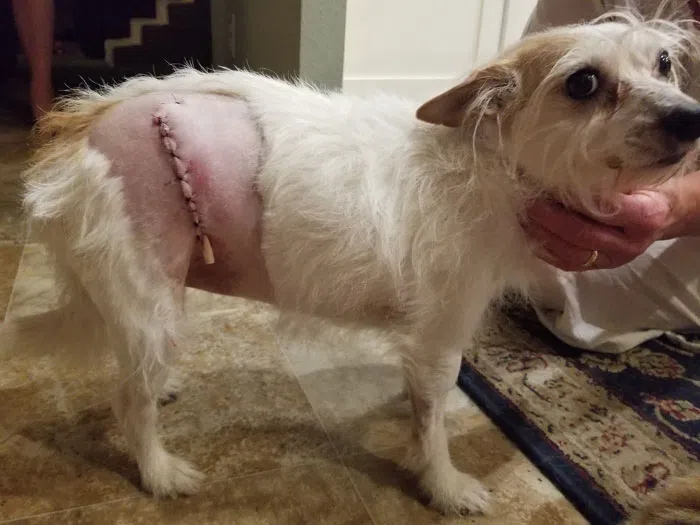In a 48-hour period last weekend, three dogs who are very close to me ended up in veterinary emergency rooms. It was a very weird aggregation of events – but each event was avoidable, and each dog’s owner has taken responsibility for their dog’s potentially deadly accident.
Beware of Wild Animals Around Your Property
The first accident happened to Daisy, my sister’s little 15-pound Jack Russell Terrier. My sister and her husband live in a rural area, where most of the homes are on lots of a half-acre or more. In addition, they live at the bottom of a steep hill, on a court with just five houses on it, and several empty lots. She sometimes allows her little dogs to potty in the empty half-acre lot next door to her house. The lot is, like her own backyard, studded with oak trees, but unlike her yard, is covered with tall grass, and the little dogs enjoy sniffing and exploring the area as they take their potty break.
On this particular day, though, what my sister failed to notice as she let the dogs wander into the lot, was a female deer apparently lounging at the back of the lot. She didn’t see the moment that two of her dogs discovered the deer – or whether the deer spotted the dogs before they spotted her. But she heard one of her dogs shrieking and as she ran in the direction of the screams, saw a large female deer rearing up and stomping down on one of her little dogs.
Like many of us, she was focused on getting to and protecting her dog, and failed to appreciate the danger to herself as she ran toward the deer. She said she was yelling, “Hey! Hey!” and about 15 feet from the deer, fully expecting the deer to spook and run from her, when it, instead, reared up and charged at HER. She screamed and waved her arms and dodged behind a tree, and fortunately, little Daisy took that opportunity to bolt away from the deer. My sister, too, turned and ran and, again, fortunately, the deer didn’t pursue either of them. I suspect that she had a baby resting nearby or some other reason to go on the offensive. My sister didn’t investigate further, as Daisy was still screaming – now in pain, rather than from fear. The deer’s hooves had made one very deep and long laceration along Daisy’s flank, and her face was bleeding, too.
A night in the ER, x-rays, pre-anesthetic bloodwork, surgery (under anesthesia) to close the laceration and insert a drain, antibiotics, and pain medication: $1,600. Nope, they don’t have pet insurance.
Don’t Leave Out Food Leftovers or Dirty Dishes

The very next morning, I received a call from a friend regarding her dog Nova, who was my favorite puppy from a litter I fostered last fall. (I used her and Nova to model for an article in WDJ not long ago, you can see them here.) She said, “I just need a little support. I am at the ER with Nova and scared!” It seems she had made barbequed ribs the night before, and had left the glass pan, covered with baked-on sauce, on the stove top, to deal with the next day. In the middle of the night, Nova had apparently knocked the pan onto the kitchen floor, where it shattered into hundreds of pieces – and she spent some time licking the sauce off of those pieces of glass! There was broken glass – and blood – all over the kitchen floor. My friend didn’t hesitate; she just put Nova into the car and drove straight to the emergency clinic.

The attending veterinarian used an endoscope (under full anesthesia) to examine Nova’s esophagus and stomach, and removed several pieces of glass – as well as several pieces of chewed-up tennis ball. She was incredibly lucky; the procedure took place quickly enough that Nova hadn’t yet vomited (which could have made the glass cause damage on the way out of the stomach and in Nova’s throat), nor had the glass hadn’t started to move through Nova’s intestines. The blood that her owner saw on the kitchen floor was definitely caused by cuts the glass made on Nova’s tongue, but none of those cuts (nor others in her esophagus) were serious enough to require surgical repair.
Total cost: $2100. Fortunately, Nova’s owner has pet health insurance. Since she had another vet visit earlier this year and has already spent the $250 deductible for 2019, she will receive a reimbursement from the insurance company for 90 percent of the most recent bill.
Nova’s owner reports: “I have learned my lesson; my counters are the cleanest in the county and there won’t ever be a mistake made like this again. Also, no more tennis balls for Nova.”
Another Counter-Surfing Case
The same afternoon that my friend was picking up Nova after her procedure, I received a text from another friend! “Ricky ate Chaco’s pain meds. We are at (a local vet clinic).”
While ALL medications should be kept in kitchen or bathroom cabinets – never on counters that dogs can reach – this is especially true of chewable medications. Most dogs won’t eat more than one nasty-tasting pill they find lying around. But the chewable kind tempts many dogs into eating the whole bottle – and that’s what Ricky did. He ate about eight Deramaxx pills, a nonsteroidal anti-inflammatory (NSAID) that can cause liver damage if an overdose is consumed.

Again, fortunately, my friend discovered the chewed-up, empty bottle right away, and drove immediately to a veterinary hospital, where they administered an injection of apomorphine, which makes dogs almost instantaneously vomit. So Ricky has (apparently) suffered no ill effects, and the bill was a quite reasonable $170 (no insurance).
We’re All Susceptible
Lest anyone think I am judging my friends: I, too, once had a dog eat a whole bottle of chewable medication meant for another dog (I wrote about that in 2013!). The experience made me VERY careful about where I put medications.
Protecting our dogs is an ongoing, complex task, and none of us can prevent every potentially fatal accident. But all of these were preventable – and my sister and friends and I all hope that these stories make you just that much more alert and able to prevent any of these accidents from befalling your dogs!
In case you want to learn about more ways to avoid a trip to the veterinary ER, here is a link to an article that veterinarian Catherine Ashe (who practiced emergency veterinary medicine for nine years) wrote for us last year.










